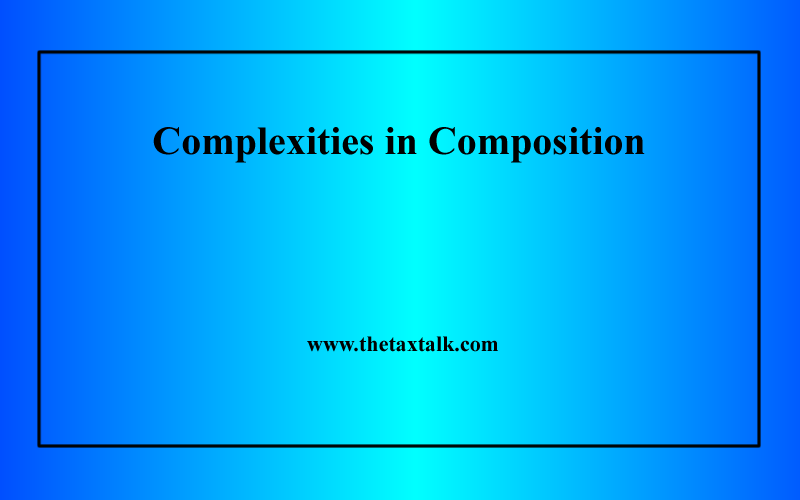![]()
Complexities in Composition
Goods and Services Tax (GST) is one of the most dynamic laws in Indian Scenario. Section 10 of CGST Act, 2017 have concept of Composition Levy. Similar section was also there Value Added Tax (VAT) which is now subsumed under GST.
Composition Levy permits a person to pay GST at a flat rate on the outward supply without claiming the benefit of input tax credit. The basic reason of introduction of this system is that some of the businessman having variety of products for trading and it becomes cumbersome for them to maintain product by product details. Another benefit is that one needs to file only 1 return per quarter if he/she opted for composition. For example, a person running grocery shop or a stationery shop may opt for this scheme to reduce the compliances.
Earlier, only those who were traders or manufacturers were allowed to opt for this scheme. Service providers were strictly out of the picture of Composition except for restaurants, catering etc. Due to this, registered persons engaged in the supply of services (other than restaurant services) are not eligible for composition scheme. As a result, manufacturers and traders supplying services are unable to opt for the scheme even if its percentage of service is very small as compared to the supplies of goods. With a view to enable these taxpayers to avail of the benefit of composition scheme, a new proviso is being added in order to allow them to be eligible for the scheme even if they supply services of value not exceeding 10% of the turnover in the preceding financial year in a State/Union territory or Rs. 5 lakhs, whichever is higher. This is a taxpayer-friendly measure and it is believed that small taxpayers would immensely benefit from this amendment. This is a consequential amendment, as a new proviso is being added to section 10 (1) which allows the registered person to opt for the scheme even if they supply services of value not exceeding 10% of the turnover in the preceding financial year in a State/Union territory or Rs. 5 lakhs, whichever is higher. (Notification dated 30th August 2018.
The levy of composition is optional. For registration under the scheme, intimation in FORM GST REG- 01 must be filed. One may opt for this scheme only if the Aggregate Turnover in the preceding Financial Year is less than Rs. 1.5 crores (Rs. 75 lakhs for Specified categories of state except Jammu and Kashmir and Uttarakhand). Aggregate turnover shall include turnover all over India of the PAN holder including the amount of Nil Rated, Exempt, Non-GST supply. Also it shall include the turnover of export.
The flat rate at which person is liable to pay tax:
- For Manufacturers: 1% of “State Turnover” (0.5% CGST & 0.5% SGST)
- For Traders: 1% of “Taxable Supplies” (0.5% CGST & 0.5% SGST)
- For Restaurants, Catering, etc.: 5% of “State Turnover” (2.5% CGST & 2.5% SGST)
All we have studied above seems to be advantageous to the composite dealer as a lot of the administration cost will be reduced and person has to pay minimal rate of tax.
Now coming to the conditions that are to be followed for opting into this scheme:
- The basic condition is that the person opting for composition levy is not permitted to claim the Input Tax Credit (ITC) on inward as well as on the taxes paid under Reverse Charge Mechanism (RCM).
- The composite dealer cannot pass on the burden of the tax paid at above mentioned rates to the customers.
- The person is liable to pay reverse charge on the supplies notified u/s 9(3) & 9(4) of CGST Act, 2017. Although he need not maintain his books but is required to keep track of inputs liable to RCM and pay the tax at the rate notified for the relevant RCM supply.
- No inter-state supplies would be permitted if the person opted for composition scheme.
- If the aggregate turnover exceeds the threshold limit the person will have to opt out of the scheme and will not be eligible for opting in the scheme for the next year. However, he shall be eligible for opting in the scheme in third year if the turnover is below the threshold in second year.
- The manufactures of Ice-cream, Pan Masala and Tobacco are not allowed to opt for this scheme.
- The biggest drawback of the scheme is that if there are number of branches in different states of the same PAN holder and one of the branch is not eligible for this scheme than all the other are also not eligible. If one opts for composition others have to compulsorily opt for composition scheme.
Think that the person’s one branch is in specified state and the person wants to opt for composition in all the states he has branches. The effective threshold will come to Rs. 75 lakhs instead of 1.5 crores since branch is situated at specified area,
So, to conclude composition scheme is boon for small tax-payers who have no branches in other states nor they have inter-state supplies. It is a best step in case of transfer from registered to unregistered.

